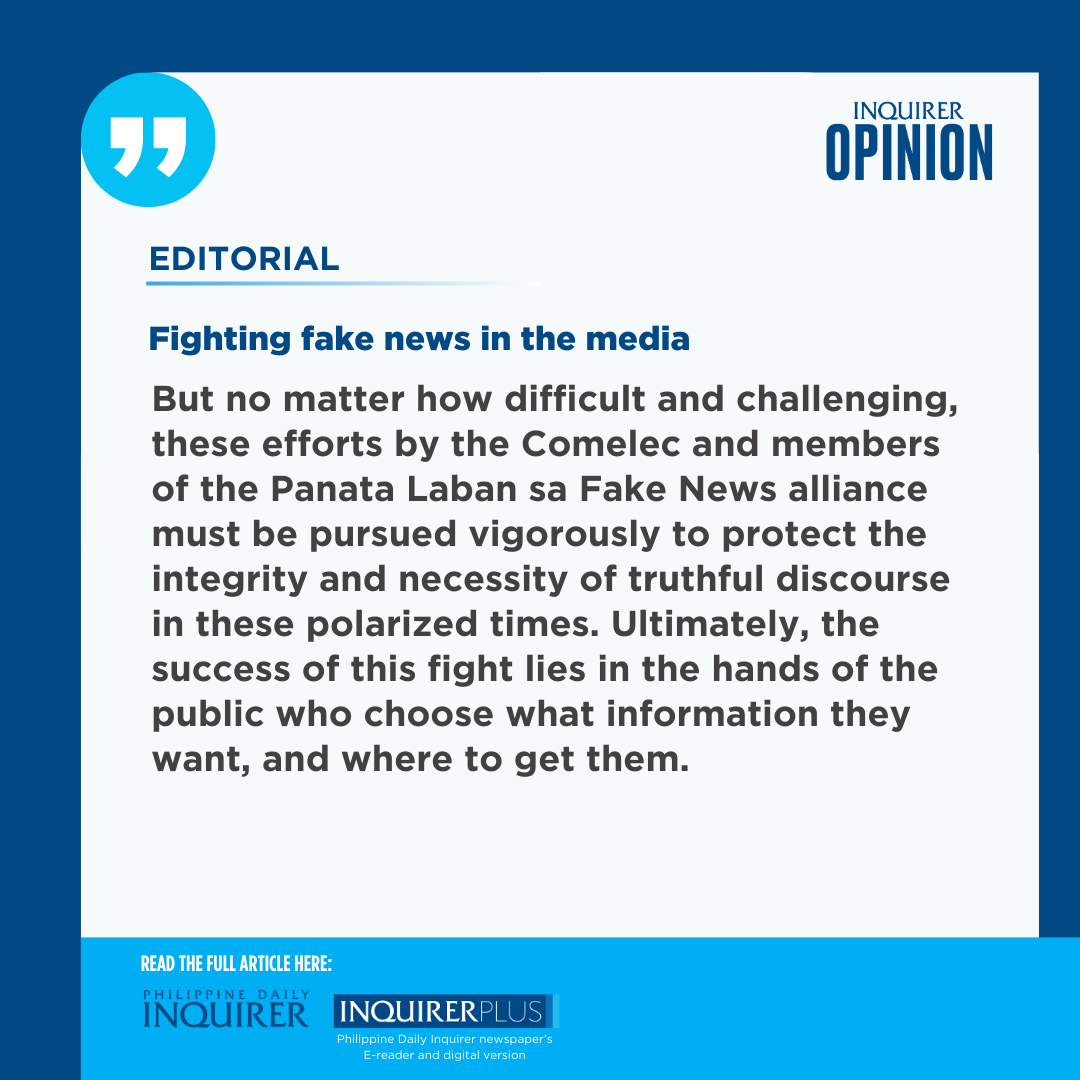Fighting fake news in the media
Truth] is not always the most viral, but it remains to be the best story to tell.”
This statement, by GMA Network chair Felipe Gozon, sums up the vision of a landmark coalition of major media organizations and academic institutions launched last week, to combat fake news and disinformation as the 2025 midterm elections draw closer.
Article continues after this advertisementAround 60 partners signed up for the GMA Network-led “Panata Kontra Fake News” (Pledge Against Fake News), including the Philippine Daily Inquirer (PDI) and several print, broadcast, and online news organizations. GMA Network and PDI are the most trusted media brands in the country, according to the 2024 Reuters Digital News Report which tracks the media landscape and the latest trends in media consumption across the world.
Among the other signatories are the Commission on Elections (Comelec) led by its chair George Garcia, and the tech giant Google.
The proliferation of fake news and disinformation in a social media-crazy country like the Philippines has been an ongoing concern, but more so as we brace for the midterm elections next year which are expected to heighten partisan tensions among allies of the country’s warring powerful leaders.
Article continues after this advertisementAs succinctly pointed out by Gozon, the problem of disinformation has become “so wide and deep” that it needs a “massive undertaking to fight it.”
Serious concern
Statistics bear out this observation. A Pulse Asia survey in September 2022 found that nine out of 10 Filipino adults believe that the proliferation of fake news is a problem. This was validated by another survey by the Social Weather Stations in 2021, which showed that 67 percent of respondents believe that fake news on the internet is a serious concern.
Moreover, more than half of the respondents said it was difficult for them to spot fake news.
This difficulty becomes even harder as most Filipinos access their news from online and social media platforms, not all of which are necessarily produced by professional media organizations trained and skilled in verifying, analyzing, and contextualizing information and critical issues affecting public interest.
According to the latest edition of the Reuters Digital News Report, online news, including social media, was the top source of news for 82 percent of Filipinos, followed by social media at 63 percent, television at 46 percent, and print at 13 percent. The study also said that Facebook, YouTube, Facebook Messenger, TikTok, Instagram, and X (formerly Twitter) remain the top sources of news in the Philippines.
Lonely voice
Yet these top tech companies have been criticized for failing to regulate harmful content on their platforms, including fake news, disinformation, misinformation, and propaganda, and constantly bombarding users with content based on algorithms that track their preferences and biases.
Against such a backdrop, fighting disinformation is truly a formidable endeavor.
Without a shift in people’s discernment and behavior, such campaign against fake news will remain a lonely voice in the (social media) wilderness. It is thus noteworthy that GMA Network vowed to offer content that will educate the public about fake news and how to fight it. The rallying cry “Magkaisa tayong labanan ang fake (Let us be united in fighting fake news)” comes as a timely call for collective action.
On top of indifferent social media platforms comes now the proliferation of artificial intelligence (AI)-enabled disinformation, such as deepfake or manipulated videos, a bigger concern among netizens who may not be tech-savvy enough to discern such sophistry.
In the United States, for instance, researchers have raised concerns that tech-fueled political disinformation could be used to manipulate voters, and stoke tensions as the country heads to a showdown between Democratic presidential candidate Vice President Kamala Harris and Republican bet Donald Trump in November.
Ambitious proposal
On Wednesday, President Marcos described as fake news rumors that he had a medical emergency while a manipulated photo earlier showed him supposedly doing drugs.
Aware of the possible use of deepfakes in the coming 2025 polls, Comelec’s Garcia has proposed a ban on the use of AI technology by candidates in their election campaign.
While some sectors have warned that the Comelec proposal could infringe on freedom of expression, others have wondered how the election body could prohibit the use of such tech-driven content. Garcia remains unfazed, with the Comelec expected to release guidelines on this ambitious proposal soon, including the penalty of disqualification for candidates violating the ban.
But no matter how difficult and challenging, these efforts by the Comelec and members of the Panata Laban sa Fake News alliance must be pursued vigorously to protect the integrity and necessity of truthful discourse in these polarized times.
Ultimately, the success of this fight lies in the hands of the public who choose what information they want, and where to get them. Advocates of truth can only hope that they would choose to be enlightened.
















